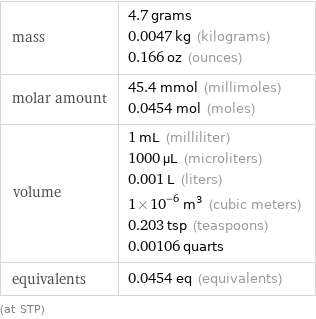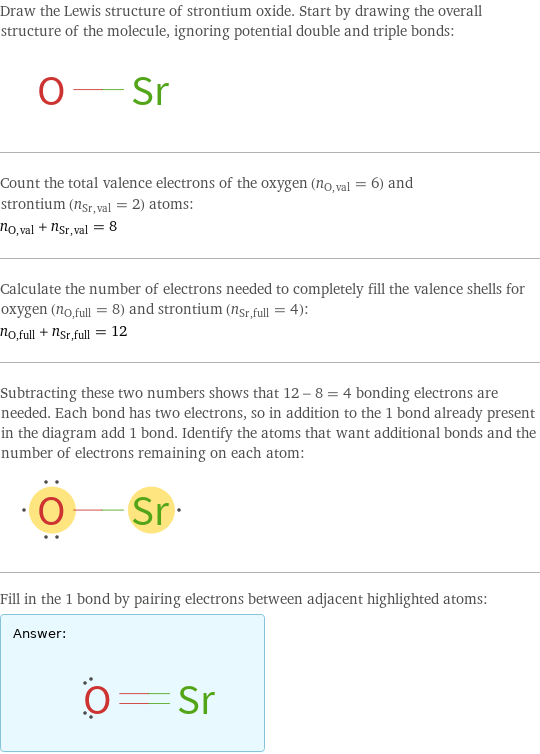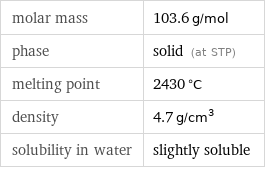Input interpretation

1 cm^3 of strontium oxide
Basic properties for 1 cm^3

mass | 4.7 grams 0.0047 kg (kilograms) 0.166 oz (ounces) molar amount | 45.4 mmol (millimoles) 0.0454 mol (moles) volume | 1 mL (milliliter) 1000 µL (microliters) 0.001 L (liters) 1×10^-6 m^3 (cubic meters) 0.203 tsp (teaspoons) 0.00106 quarts equivalents | 0.0454 eq (equivalents) (at STP)
Corresponding quantities

sphere radius | 6.204 mm (millimeters) side of a cube | 10 mm (millimeters)
Thermodynamic properties for 1 cm^3

heat capacity C_p | solid | 2.041 J/K free energy of formation Δ_fG° | solid | -25.49 kJ heat of formation Δ_fH° | gaseous | 0.06804 kJ | solid | -26.85 kJ latent heat of fusion | 3.67 kJ (kilojoules) |
Units

Phase change energies for 1 cm^3 from 25 °C

energy required to heat to melting point | 4.91 kJ (kilojoules) energy required to convert to liquid | 3.67 kJ (kilojoules) energy required to heat to melting point and convert to liquid | 8.58 kJ (kilojoules)
Mass composition for 1 cm^3

O (oxygen) | 0.726 g (15.4%) Sr (strontium) | 3.974 g (84.6%)

Mass composition for 1 cm^3
Lewis structure

Draw the Lewis structure of strontium oxide. Start by drawing the overall structure of the molecule, ignoring potential double and triple bonds: Count the total valence electrons of the oxygen (n_O, val = 6) and strontium (n_Sr, val = 2) atoms: n_O, val + n_Sr, val = 8 Calculate the number of electrons needed to completely fill the valence shells for oxygen (n_O, full = 8) and strontium (n_Sr, full = 4): n_O, full + n_Sr, full = 12 Subtracting these two numbers shows that 12 - 8 = 4 bonding electrons are needed. Each bond has two electrons, so in addition to the 1 bond already present in the diagram add 1 bond. Identify the atoms that want additional bonds and the number of electrons remaining on each atom: Fill in the 1 bond by pairing electrons between adjacent highlighted atoms: Answer: | |
Chemical names and formulas

formula | SrO Hill formula | OSr name | strontium oxide IUPAC name | oxostrontium
Substance properties

molar mass | 103.6 g/mol phase | solid (at STP) melting point | 2430 °C density | 4.7 g/cm^3 solubility in water | slightly soluble
Units
